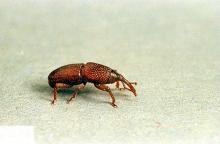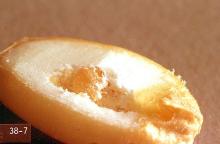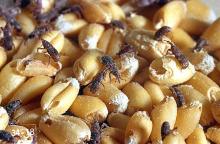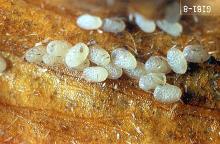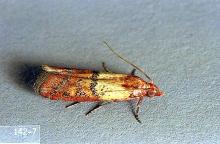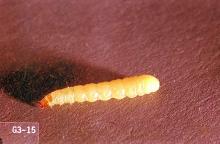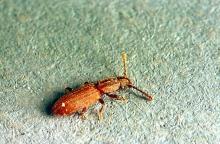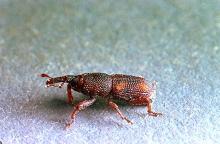Includes
Almond moth (Ephestia cautella)
Angoumois grain moth (Sitotroga cerealella)
Flour beetle (Tribolium spp.)
Granary weevil (Sitophilus granaries)
Indian meal moth (Plodia interpunctella)
Rice weevil (Sitophilus oryzae)
Saw-toothed grain beetle (Oryzaephilus surinamensis)
Storing grain properly
Store only clean, dry grain containing less than 12 % moisture. Grain mixed with green weed seeds, broken kernels, or dirt provides conditions favorable for insect development.
Aerate grain
Moisture condensation can develop in storage bins when unequal temperatures in the grain mass cause gradual circulation of air from the warm to the cold grain. As air passes through the warm center of the grain, small convection currents pick up moisture and deposit it in the cold areas. This can result in spoiled, crusted grain on the surface, in the middle of the bin, in the top center, or along the outside.
To prevent condensation, aeration is needed to keep the grain within 15°F of the average outside temperature. Start aeration fans shortly after harvest and run them periodically until November. In the spring, aeration should be used to raise the temperature of the grain to about 50°F.
Inspect grain
Inspect stored grain once a month. You can detect infestations using a grain probe or by hand. Hot areas generally indicate an infestation. Watch especially for signs of crusting near the top-center and outside edges. You might see live insects and damaged kernels on the surface, especially at the crown. Surprisingly, large populations of these pests can develop by mid-winter. Light traps, pheromone kits, and other types of traps are available for collecting, detecting, and monitoring many pests.
Prevention
Good housekeeping and rapid inventory liquidation are key to preventing infestations. Before harvest and grain storage: (1) remove grain, or else treat grain that is to remain in storage. Grain stored over 9 months is susceptible to infestation; (2) thoroughly clean with industrial vacuum the storage warehouse, floors, walls, ceilings, cracks and crevices, and all equipment. The most common source of insect infestation for newly stored grain is old grain residue which is everywhere: in and on trucks, trailers, combines, dump pits, bins, augers, and virtually anywhere that grain passes or is stored. Infestations may be introduced on pallets or in contaminated or infested bags of grain or seed, even though these may appear to be clean. Pelleted livestock feed, dry animal foods, feathers, and old hides may also harbor the pests that infest stored grain.
Protection
Insecticides are highly recommended for treating the interior walls and floor. Malathion products, Tempo Ultra SC and Tempo 20WP (cyfluthrin), and Storcide II (chlorpyrifos-methyl+deltamethrin) are registered for surface treatments. Apply according to label instructions. Bin wall and floor treatments should be made at least 1 week before filling. Note: No international level of tolerance has been established for cyfluthrin. Grain treated with this product may not be accepted in international markets. Avoid contaminating storage areas where exported grains may be stored. Caution—Some buyers will not accept insecticide-treated grain. Check with your local elevator before treating.
Grain to be stored 9 months or longer is often treated for protection against beetles and moths when put into storage. The possibility exists for rapid infestation as the protectant breaks down; storage longer than 18 months is not recommended. Protectants are added to the grain as it is unloaded, or as it enters the bin for final storage. To be effective, protectants must be mixed thoroughly with the grain. If subsequent surface infestations are detected, try to determine the reason (e.g., a leaky roof leading to moistening of the grain) and correct the root cause. Minor infestations can be treated by incorporating a registered product into the top 8 to 10 inches of grain.
Management—chemical control
Direct grain treatments
- Bacillus thuringiensis kurstaki (Biobit HP) at 0.5 lb in 5 to 10 gal water per 500 sq ft of grain surface area, mix into top 4 inches for Indian meal moth, Angoumois grain moth, and almond moth. Mix with grain when placed in storage and/or periodically apply to the surface of stored grain; see labels. Biobit HP is OMRI-listed for organic use.
- deltamethrin/piperonyl butoxide (Centynal Synergized Insecticide)—For stored grain use 5 gal of dilution per 1,000 bushels to achieve a 0.5 ppm on the commodity.
- deltamethrin/piperonyl butoxide/s-methoprene (Gravista Insecticide)—Apply solution at the rate of 3 to 5 gal of dilution per 1,000 bushels to achieve a 0.5 ppm concentration of deltamethrin and 1.2 ppm of S-methoprene on the commodity. See the label for specific grain commodity recommendations.
- deltamethrin/s-methprene (Diacon IGR Plus)—Apply at the rate of 3 to 5 gal of dilution per 1,000 bushels. See the label for specific grain commodity recommendations.
- imidacloprid (Dyna-Shield Imidacloprid) at 1.0 fl oz per 100 lb of seed.
- malathion (Fyfanon 57% and Malathion 57%)—Mix 8 pints per 25 gal water. Apply 3 gal per 1,000 sq ft.
- piperonyl butoxide/pyrethrins (Stryker Insecticide Concentrate)—For surface treatment dilute 1 part Stryker with 19 parts water and apply at the rate of 1 to 2 gal per 1,000 sq ft. For grain protectant dilute at the rate of 1 part concentrate to 29 parts water. Apply 4 to 5 gal per 1,000 bu. of grain.
- pirimiphos-methyl (Actellic 5E Insecticide) at 5 lb ai/gal. For top dressing treatment apply 3 fl oz in 2 gal water per 1,000 square feet of grain surface. Washington only.
- pyrethrins (Evergreen Pyrethrin)—Dilute 1 part product with 14 parts water and apply at the rate of 2 gal per 1,000 sq ft of grain to a depth of 4 inches.
- s-methoprene (Diacon IGR) at 2.5 lb ai/gal. Apply 21 fl oz per ton of grain.
- spinosad (Sensat) at 0.73 lb ai/gal. For crops typically treated per ton (2,000 lb) apply 0.35 fl oz or 10.4 ml per ton to deliver 1 ppm of active ingredient. For top dressing treatments: for each 1,000 sq ft of surface, mix 2.6 fl oz of Sensat in 2 gal water.
Storage building—residual spray or space treatment
- beta-cyfluthrin (Tempo SC Ultra) at 0.034 to 0.067 oz ai (8 to 16 ml)/1,000 sq ft as surface spray for stainless steel units. No international level of tolerance has been established for cyfluthrin. Grain treated with this product may not be accepted in international markets. Avoid contaminating storage areas where exported grains may be stored.
- bifenthrin (Bisect L)—Apply using a 0.02 to 0.06% dilution. Apply as a coarse, low-pressure spray to areas where these pests hide, i.e., cracks and crevasses.
- ddvp (Max Kill Vapocide, Nuvan Aerosol)—Apply as fog or as a ULV coarse spray at a rate of 1 to 2 grams of dichlorvos (0.5 to 1 fl oz) per 1,000 cu ft. Do not make applications when temperatures are below 60°F.
- deltamethrin (Suspend SC) at 0.08 to 0.5 lb. ai per 100-gal final spray in grain bins and warehouses. Apply to surfaces at 1 gal per 1,000 sq ft. Before storing or handling grain, apply finished spray to equipment, wall and floor surfaces of grain bins and warehouses at the rate of 1 gal per 1,000 sq ft.
- lambda-cyhalothrin (Lamdastar Ultracap) at 0.2 to 0.4 fl oz per gal water (0.015 to 0.03% ai). All outdoor applications must be limited to spot or crack-and-crevice treatments only.
- malathion (Loveland Malathion 57EC) at 0.6 lb ai in 3 gal water and apply on 1,000 sq ft to grain storage facilities. Do not apply to grain.
- piperonyl butoxide/pyrethrins (Stryker Insecticide Concentrate)—For surface treatment dilute 1 part Stryker with 19 parts water and apply at the rate of 1 to 2 gal per 1,000 sq ft.
- pyrethrins/synergist (Py-75, Pyrocide 100, TurboCide Gold) as a contact spray per 1,000 sq ft and followed as a space spray per 1,000 cu ft. Rates vary; check the label.
- pyriproxyfen-nylar (Turbocide Advanced Fogging Products IGR)—Apply as a space spray at a rate of 0.335 oz (9.5 grams) per 1,000 cu ft of room space.
- tetradecadienyl acetate (Cidetrak IMM)—Apply 1 dispenser per 14,124 to 42,376 cu ft. Apply maximum rate to heavily infested buildings. Do not exceed 200 grams ai per 7,063 cu ft per year.
- s-methoprene (Diacon IGR) may be used as a fogging concentrate. Methoprene does not kill adult insects but rather prevents reproduction.


